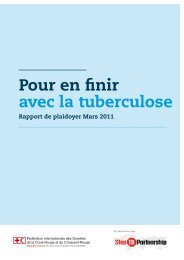Guidelines for intensified tuberculosis case-finding and isoniazid ...
Guidelines for intensified tuberculosis case-finding and isoniazid ...
Guidelines for intensified tuberculosis case-finding and isoniazid ...
Create successful ePaper yourself
Turn your PDF publications into a flip-book with our unique Google optimized e-Paper software.
Medicine, 1994, 9:695–721.<br />
31. Markowitz N et al. Tuberculin <strong>and</strong> anergy testing in HIV-seropositive <strong>and</strong> HIV-seronegative persons. Pulmonary<br />
Complications of HIV Infection Study Group. Annals of Internal Medicine, 1993, 119:185–193.<br />
32. Aichelburg MC et al. Detection <strong>and</strong> prediction of active <strong>tuberculosis</strong> disease by a whole-blood interferon-gamma<br />
release assay in HIV-1-infected individuals. Clinical Infectious Diseases, 2009, 48:954–962.<br />
33. Clark SA et al. Tuberculosis antigen-specific immune responses can be detected using enzyme-linked immunospot<br />
technology in human immunodeficiency virus (HIV)-1 patients with advanced disease. Clinical <strong>and</strong> Experimental<br />
Immunology, 2007, 150:238–244.<br />
34. Dheda K et al. T-cell interferon-gamma release assays <strong>for</strong> the rapid immunodiagnosis of <strong>tuberculosis</strong>: clinical utility<br />
in high-burden vs low-burden settings. Current Opinion in Pulmonary Medicine, 2009, 15:188–200.<br />
35. WHO. Three interlinked patient monitoring systems <strong>for</strong> HIV Care/ART, MCH/PMTCT <strong>and</strong> TB/HIV: st<strong>and</strong>ardized<br />
minimum data set <strong>and</strong> illustrative tools. Geneva, Switzerl<strong>and</strong>, World Health Organization, 2009.<br />
36. WHO, UNAIDS <strong>and</strong> OGAC. A guide to monitoring <strong>and</strong> evaluation <strong>for</strong> collaborative TB/HIV activities. Geneva,<br />
Switzerl<strong>and</strong>, World Health Organization, 2009 (WHO/HTM/TB/2009.414; WHO/HTM/HIV 09.01).<br />
37. Granich R et al. Prevention of <strong>tuberculosis</strong> in people living with HIV. Clinical Infectious Diseases, 2010, 50:S215–<br />
S222; doi:10.1086/651494.<br />
38. Balcells ME et al. Isoniazid preventive therapy <strong>and</strong> risk <strong>for</strong> resistant <strong>tuberculosis</strong>. Emerging Infectious Diseases,<br />
2006, 12:744–751.<br />
39. Van Halsema CL et al. Tuberculosis outcomes <strong>and</strong> drug susceptibility in individuals exposed to <strong>isoniazid</strong> preventive<br />
therapy in a high HIV prevalence setting. AIDS, 2010, 24:1051–1055.<br />
40. Halsey NA et al. R<strong>and</strong>omised trial of <strong>isoniazid</strong> versus rifampicin <strong>and</strong> pyrazinamide <strong>for</strong> prevention of <strong>tuberculosis</strong> in<br />
HIV-1 infection. Lancet, 1998, 351:786–792.<br />
41. Souza CT et al. Effectiveness <strong>and</strong> safety of <strong>isoniazid</strong> chemoprophylaxis <strong>for</strong> HIV-1 infected patients from Rio de<br />
Janeiro. Memórias do Instituto Oswaldo Cruz, 2009, 104:462–467.<br />
42. Hawken MP et al. Isoniazid preventive therapy <strong>for</strong> <strong>tuberculosis</strong> in HIV-1-infected adults: results of a r<strong>and</strong>omized<br />
controlled trial. AIDS, 1997, 11:875–882.<br />
43. Mwinga A et al. Twice weekly <strong>tuberculosis</strong> preventive therapy in HIV infection in Zambia. AIDS, 1998, 12:2447–<br />
2457.<br />
44. Whalen CC et al. A trial of three regimens to prevent <strong>tuberculosis</strong> in Ug<strong>and</strong>an adults infected with the human<br />
immunodeficiency virus. Ug<strong>and</strong>a–Case Western Reserve University Research Collaboration. New Engl<strong>and</strong> Journal<br />
of Medicine, 1997, 337:801–808.<br />
45. WHO. Antiretroviral therapy <strong>for</strong> HIV infection in infants <strong>and</strong> children: towards universal access. Recommendations<br />
<strong>for</strong> a public health approach. 2010 revision. Geneva, Switzerl<strong>and</strong>, World Health Organization, 2010.<br />
46. Edwards DJ, Kitetele F, Van Rie A. Agreement between clinical scoring systems used <strong>for</strong> the diagnosis of pediatric<br />
<strong>tuberculosis</strong> in the HIV era. International Journal of Tuberculosis <strong>and</strong> Lung Disease, 2007, 11:263–269.<br />
47. Song R et al. Evaluation of TB screening approaches among HIV-infected children – Rw<strong>and</strong>a, 2008. 5th IAS<br />
conference on HIV pathogenesis <strong>and</strong> treatment, 19–22 July 2009 [Abstract no TUPEB132].<br />
48. Marais BJ et al. A refined symptom-based approach to diagnose pulmonary <strong>tuberculosis</strong> in children. Pediatrics,<br />
2006, 118:e1350–1359.<br />
49. Zar HJ et al. Effect of <strong>isoniazid</strong> prophylaxis on mortality <strong>and</strong> incidence of <strong>tuberculosis</strong> in children with HIV: r<strong>and</strong>omised<br />
controlled trial. British Medical Journal, 2007, 334:136.<br />
50. M<strong>and</strong>alakas AM et al. High level of discordant IGRA results in HIV-infected adults <strong>and</strong> children. International Journal<br />
of Tuberculosis <strong>and</strong> Lung Disease, 2008, 12:417–423.<br />
51. Liebeschuetz S et al. Diagnosis of <strong>tuberculosis</strong> in South African children with a T-cell-based assay: a prospective<br />
cohort study. Lancet, 2004, 364:2196–2203.<br />
52. Davies MA et al. Detection of <strong>tuberculosis</strong> in HIV-infected children using an enzyme-linked immunospot assay.<br />
AIDS, 2009, 23:961–969.<br />
53. WHO/The Union. Guidance <strong>for</strong> national <strong>tuberculosis</strong> <strong>and</strong> HIV programmes on the management of <strong>tuberculosis</strong><br />
in HIV-infected children: recommendations <strong>for</strong> a public health approach. 2010. Available at: http://www.tbcta.org//<br />
Uploaded_files/Zelf/TBHIVchildfinaldoc1203101268950707.pdf (accessed on 26 October 2010).<br />
54. WHO. Priority research questions <strong>for</strong> TB/HIV in HIV-prevalent <strong>and</strong> resource-limited settings. Geneva, Switzerl<strong>and</strong>,<br />
World Health Organization, 2010.<br />
29



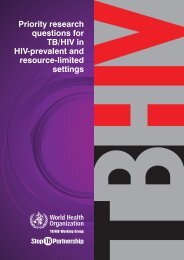
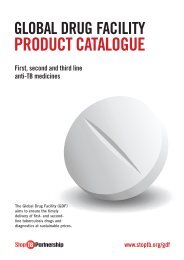
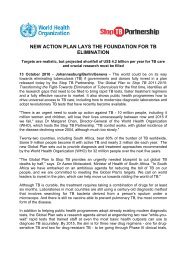
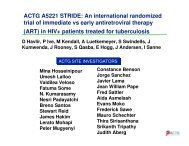
![Global Drug Facility Annual Report 2011 [.pdf] - Stop TB Partnership](https://img.yumpu.com/26788745/1/184x260/global-drug-facility-annual-report-2011-pdf-stop-tb-partnership.jpg?quality=85)
![Concept note on national stop TB partnership [.pdf]](https://img.yumpu.com/26788741/1/184x260/concept-note-on-national-stop-tb-partnership-pdf.jpg?quality=85)
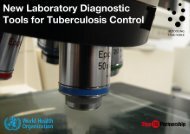

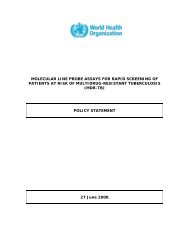
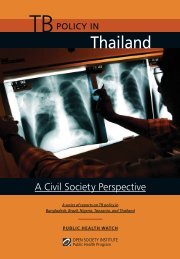
![2005 and Challenges for 2006 - 2015 [.pdf] - Stop TB Partnership](https://img.yumpu.com/26788674/1/190x245/2005-and-challenges-for-2006-2015-pdf-stop-tb-partnership.jpg?quality=85)
![Brochure (French) [.pdf] - Stop TB Partnership](https://img.yumpu.com/17234792/1/190x91/brochure-french-pdf-stop-tb-partnership.jpg?quality=85)

